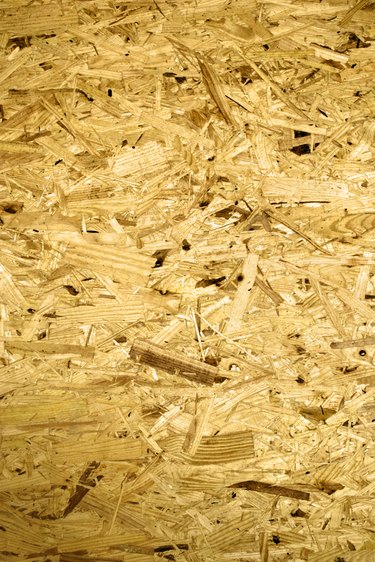
Chipboard is generally made from shavings and chunks of recycled hardwood or softwood bound together with resin. It is very useful as a less expensive alternative to plywood. While it is used extensively for flooring, furniture and shelving, it is prone to expanding and discoloration due to moisture retention. For this reason, chipboard is primarily used in indoor construction. Choose from different grades of particle board with varying levels of strength to fit your project requirements.
Repairing Squeaking Chipboard Floors
Video of the Day
From the moment construction is completed on a new house, a number of factors conspire to loosen chipboard flooring and eventually create that familiar and irritating squeaking as you walk about. Chipboard flooring is loosened as the house settles or as central heat and air expand and contract the sheets of chipboard, which then rub against the nails. Identify the squeaking boards, remove the nails and drive exterior-grade screws tightly into the nail holes.
Video of the Day
Repairing Chipboard Shelves
Chipboard shelving sometimes breaks loose and crumbles at the point where it is connected to the cabinet with nails or screws. The chipboard shelving continues to break apart unless it is repaired. Begin by blowing out loose chipboard particles with an air compressor. Brace another board against the torn-out spot and fill it with epoxy putty, using the other board to hold in the putty as it hardens. Sand off the hardened putty, reinsert the screw and replace the shelf.
Repairing Scratched Chipboard Surfaces
While chipboard furniture is generally not as expensive as wood, it is susceptible to the same types of damage. Remove scratch marks on chipboard by polishing them with a clean soft cloth and furniture polish to remove grime and loose chipboard fibers. Use a furniture marker pen that is the color of the chipboard to thoroughly color in the scratch mark. After the marker dries, press down a wax pencil over the scratch until the mark is filled and polish with furniture polish.
Removing White Moisture Stains
Setting a glass on chipboard furniture mars the finish when condensation occurs and the moisture penetrates the wood. The white rings that result can be removed by dampening a soft cloth with denatured alcohol and gently polishing out the stain. Rub stubborn stains gently with extra-fine 0000 steel wool and paste wax. Apply a small amount of auto polishing compound with a soft cloth to produce a glossy finish.